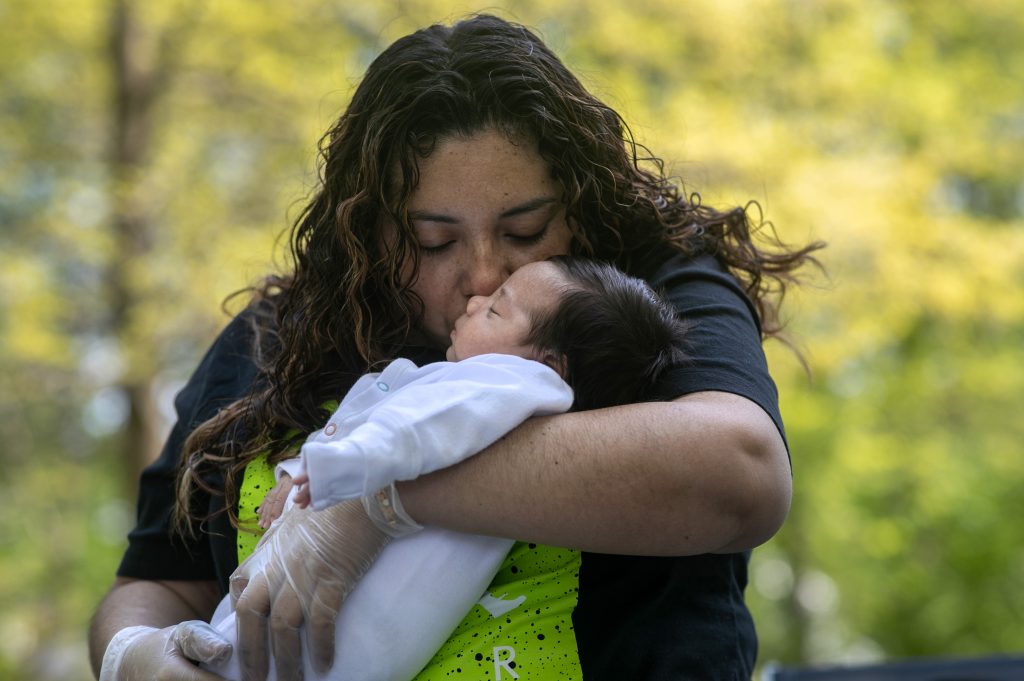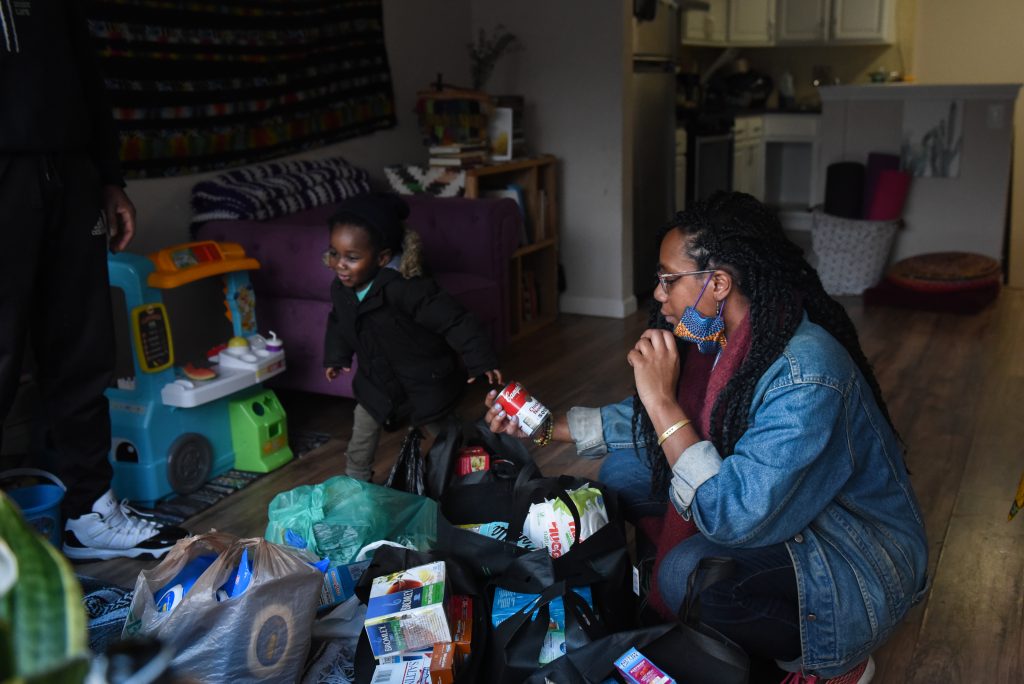Medicaid is a lifeline for millions of low-income women and families. As a critical source of health insurance coverage for maternity care, Medicaid covered approximately 43.1 percent of all births nationally in 2018.1 Pregnancy-related benefits under the program are limited: women with incomes under 133 percent of the federal poverty line (FPL) receive prenatal care, labor and delivery, and postpartum care for only sixty days after giving birth. Black and Hispanic women, as well as other women of color, make up a disproportionate share of Medicaid enrollees.2
Black women are also more likely than other groups to die or experience serious illness and injury due to pregnancy-related causes. One of the widest disparities is seen when comparing the maternal deaths of white women and non-Hispanic Black women. According to the Centers for Disease Control and Prevention (CDC), non-Hispanic Black women are approximately three times more likely to die of pregnancy-related causes than white women.3 Native-American and Alaska-Native women are about two times more likely to die than white women. The majority of national maternal deaths, a rate of 17.4 deaths per 100,000 live births,4 occur during delivery and up to one year postpartum. The majority of pregnancy-related deaths are also preventable.5
Women of all races are more likely to die from pregnancy-related causes in the weeks following birth than during pregnancy or delivery.6 In the years 2011 through 2015, a third of all pregnancy-related deaths occurred in the postpartum period; about 12 percent occurred beyond the first six weeks, 43–365 days after delivery.7 A greater proportion of deaths among Black women occurred during this period compared to the proportion of deaths among white women during the same period.8 Causes of death vary by timing as well. Deaths caused by cardiomyopathy occur most often 43–365 days postpartum, which is one of the leading causes of maternal deaths for Black and Native women.9
For Black women in particular, giving birth in the United States can be a matter of life or death, regardless of income level, education, socioeconomic status, or zip code. Health care coverage, quality of care, and access issues are challenges for Black women; however, so too are racism, sexism, and bias, which plague their experiences and interactions with the health care system.10 Because so many women of color are covered by Medicaid, and because many maternal deaths and health complications occur within one year after giving birth, extending postpartum coverage to at least one year is an essential tool in national efforts to reduce maternal mortality, eliminate racial and ethnic health disparities, and advance health equity.
Methods
For this project, The Century Foundation examined the impact of Medicaid coverage loss at sixty days postpartum. Our researchers conducted qualitative analyses of public policy efforts in three states: Illinois, New Jersey, and South Carolina. States were selected based on geographic location and local efforts to extend Medicaid coverage postpartum. Qualitative analysis consisted of extensive document review, analysis of existing literature on the postpartum coverage gap, and interviews of subject matter experts and key stakeholders, including Medicaid directors, researchers, physicians, local elected officials, community-based health care workers, and women whose pregnancies were covered by Medicaid.
Key Findings
Illinois, New Jersey, and South Carolina all have vast racial disparities in maternal mortality and finance a significant share of births through the Medicaid program (see Table 1). Across interviews, the importance of maintaining continuity of care, namely for low-income women and women of color, was a main theme. Interviewees in all three states referenced lack of access to contraception and mental health services, mismanagement of chronic health conditions, and lack of doula care as notable challenges women face in the postpartum period.
Table 1
| Maternal Health Outcomes for Illinois, New Jersey, and South Carolina | ||||||||
| State | State Maternal Mortality Rate (per 100,000 live births) | Non-Hispanic Black MMR | Non-Hispanic White MMR | Black/White Disparity in MMR | Medicaid Financed Births | Income Eligibility for Pregnant Women (% of FPL) | Income Eligibility for Parents (% of FPL) | Medicaid Expansion State? |
| Illinois | 49 | 109 | 38 | 2.9 | 44% | 213% | 138% | ✔ |
| New Jersey | 37 | 46.5 | 12.8 | 3.6 | 39% | 199% | 138% | ✔ |
| South Carolina | 24.7 | 46.3 | 13.7 | 3.4 | 64% | 199% | 67% | X |
State Efforts to Extend Medicaid Coverage for Mothers
Illinois and New Jersey have expanded Medicaid under the Affordable Care Act and have more generous options for supporting health care coverage for the broader population. Medicaid expansion has contributed to reductions in maternal and infant mortality rates within certain states.11 South Carolina has not expanded Medicaid.
Illinois and New Jersey have explored the Medicaid Section 1115 waiver, a process whereby states can apply to the Centers for Medicare and Medicaid Services (CMS) for permission to test new approaches to providing health coverage through Medicaid that fall outside of what is already required by federal statute.12 While South Carolina’s Section 1115 waiver provision to extend postpartum Medicaid coverage was denied, the state has not pursued additional local efforts to extend postpartum Medicaid coverage via legislation. Table 2 describes the Section 1115 Medicaid waivers sought by Illinois, New Jersey, and South Carolina.
Table 2
| Medicaid Section 1115 Waivers for Illinois, New Jersey, and South Carolina | |||||||
| State | Section 1115 Waiver | Legislation | Proposed Extension | Proposed Eligibility Threshold (% of FPL) | Status | Summary | Anticipated Impact |
| Illinois | Illinois Continuity of Care and Administrative Simplification | Public Act 101-0010 | Twelve months | 200% | Pending | Would extend full Medicaid benefits for postpartum women up to 200% FPL and provide continuous coverage until a year after birth. Would also allow managed care reinstatement and delays hospital presumptive eligibility. | Projects that approximately 5,000 women would be covered and coverage of an additional 55,788 postpartum months per year. |
| New Jersey | New Jersey FamilyCare Comprehensive Demonstration (formerly New Jersey Comprehensive Waiver) | S2020/A5600 | Six months | 205% | Pending | Would extend Medicaid benefits for postpartum women to 180 days after birth if they do not qualify for coverage after 60 days through a different eligibility category. | Projects that 8,700 women would be covered. |
| South Carolina | South Carolina Palmetto Pathways to Independence | N/A | Twelve months | 199% | Denied | Attempted to extend coverage for women up to one year postpartum, up to 194% FPL, with a 5% income disregard from 60 days to one year after birth. CMS approved the work and community engagement requirements, under which pregnant women up to 365 days postpartum are exempt. CMS approved 500 slots for pregnant women for up to twelve months postpartum with a diagnosed substance use disorder or serious mental illness to receive Medicaid, up to 194% FPL, if they are otherwise not eligible for Medicaid. | Projected that 2,000 women per month would receive coverage for an additional ten months. |
While these three states have explored options for extending Medicaid postpartum coverage, mothers continue to be impacted by coverage loss at sixty days and experience an array of challenges that go hand-in-hand with the lack of health care.
Impact of Coverage Loss
Medicaid policies have evolved over the past three decades to ensure that fewer low-income women have gone uninsured during their pregnancy or delivery.13 And due to the Affordable Care Act’s Medicaid expansion, women in expansion states have experienced fewer disruptions in postpartum coverage and increased use of postpartum outpatient care through Medicaid coverage, as well as earlier initiation of vital prenatal care.14 These factors have led to better maternal and infant health outcomes for families in expansion states. Despite these gains, women of color are still more likely to be uninsured, even during the period around pregnancy, compared to their white counterparts.15 States that have not expanded Medicaid under the Affordable Care Act have higher preconception and postpartum uninsurance rates, compared to expansion states.16
Insurance gaps and transitions between plans can affect the ability of patients and health care providers to work together to address conditions such as diabetes and high blood pressure before a woman becomes pregnant and during early prenatal care. They can also create significant barriers to seeking care and receiving help for complications after birth. Rates of perinatal insurance churning—that is, moving between different insurance plans or between insurance and uninsurance immediately before and after birth17—have fallen since the passage of the Affordable Care Act, largely due to Medicaid expansion, though there is still wide variation in rates across states. Despite these gains, over a third of all women still had an insurance change during the period from one month preconception through postpartum—and nearly 60 percent featured a period of uninsurance.18 Disruptions in insurance coverage have been found to be most common in states that have not expanded Medicaid.

Disruption in insurance coverage and uninsurance also pose issues for care coordination. For new mothers who cannot pay for care out-of-pocket, many must navigate various free clinics and nonprofit services. Amber Pendergraph-Leak, an African-American mother and lead doula with South Carolina-based perinatal support organization BirthMatters, said that she and her colleagues refer many of their clients out to other organizations in hopes that someone can help; otherwise, her clients wind up bearing the entire cost on their own. For new mothers during the postpartum period, it can be challenging to navigate health insurance, primary care providers, specialists, and other services to help with social and breastfeeding needs; mothers may also feel their own care is secondary to the baby’s health. “After birth, it becomes harder for moms to watch out for their own care. They take on the mom role,” said Dr. Patricia Lee King, the State Project Director and Quality Lead for the Illinois Perinatal Quality Collaborative (ILPQC). As Dr. Arvind Goyal, medical director for Illinois Medicaid, said:
 You’re forced to switch providers at the most vulnerable time, lugging your baby on your backpack, or however you do it. You don’t know who your next doctor would be when you don’t have insurance. You’re talking about care coordination and risk stratification services that most managed care organizations are required to provide. You lose that. You have a care coordinator who checked on you once a month and suddenly there is nobody checking on you, nobody worried about your transportation, nobody getting you to the doctor.
You’re forced to switch providers at the most vulnerable time, lugging your baby on your backpack, or however you do it. You don’t know who your next doctor would be when you don’t have insurance. You’re talking about care coordination and risk stratification services that most managed care organizations are required to provide. You lose that. You have a care coordinator who checked on you once a month and suddenly there is nobody checking on you, nobody worried about your transportation, nobody getting you to the doctor.
Retention in care is also vital for screening and treatment for physical, mental, and behavioral health issues that may arise during the postpartum period. “Not everything is going to come up for you within sixty days,” said Cassie Calderone, a Latina doula with Love Your Doula based in Illinois. Love Your Doula offers labor support, postpartum doula services, and lactation services, with specializations for Spanish speaking families, LGBTQA+ families, and women and families of color. Calderone said:
 We worked with a mom who had signs of preeclampsia throughout her pregnancy and wound up getting induced for preeclampsia. English is her second language. She was covered by Medicaid. She had her baby, then she went home, and she had to go back to the hospital. Well, during this time, they found out she had a heart condition, so she had to get that treated. She was able to use her [Medicaid card] to have that taken care of . . . but then she had to get major procedures done within a timeline of the sixty days. But the doctors wouldn’t diagnose her because she had just had a baby. They would ask, is this pregnancy related? As doulas, we don’t do anything medical, but it’s our job to provide resources and support. So how are we going to find her somewhere that will help her with her medical care for free because of the issues for coverage? She went to our county hospital and another clinic that took free clients.
We worked with a mom who had signs of preeclampsia throughout her pregnancy and wound up getting induced for preeclampsia. English is her second language. She was covered by Medicaid. She had her baby, then she went home, and she had to go back to the hospital. Well, during this time, they found out she had a heart condition, so she had to get that treated. She was able to use her [Medicaid card] to have that taken care of . . . but then she had to get major procedures done within a timeline of the sixty days. But the doctors wouldn’t diagnose her because she had just had a baby. They would ask, is this pregnancy related? As doulas, we don’t do anything medical, but it’s our job to provide resources and support. So how are we going to find her somewhere that will help her with her medical care for free because of the issues for coverage? She went to our county hospital and another clinic that took free clients.
For mothers who have recently given birth, falling into the coverage gap or experiencing a temporary lapse in coverage can also mean hefty out-of-pocket costs when they do seek care.19 For others, these costs can lead them to delay or forgo care altogether.20 Women who are not engaged in preventive care can face even higher costs down the road for conditions that go unscreened, unmonitored, and untreated. Dr. Goyal asserted that “if women lose coverage after sixty days, one issue is that they are unable to afford access to care, and they’re unable to afford any medications that they might need without that coverage.” Pendergraph-Leak relayed this account:
 For one of my moms, the hospital had left a piece of [the] placenta inside of her. She bled out really bad. She ended up having to have surgery, but she still had health issues from that; she actually passed out again after. And that was after Medicaid had got cut off. This health issue wasn’t even her fault. It was the hospital’s. She was able to get the help but she had to pay—her and her boyfriend had to spend quite a bit of money.
For one of my moms, the hospital had left a piece of [the] placenta inside of her. She bled out really bad. She ended up having to have surgery, but she still had health issues from that; she actually passed out again after. And that was after Medicaid had got cut off. This health issue wasn’t even her fault. It was the hospital’s. She was able to get the help but she had to pay—her and her boyfriend had to spend quite a bit of money.
Pendergraph-Leak herself was covered by Medicaid for the birth of her first child and lost coverage sixty days after giving birth. She was not able to regain health insurance until her son was 3 months old. The majority of her clients are on Medicaid, and she has worked with mothers who have developed major pregnancy-related health issues after their Medicaid benefits had been cut off.
Access to quality health care also arises as a major challenge for mothers that lose coverage and is an important determinant of positive health outcomes. Timely care can help identify, manage, and treat health conditions that complicate pregnancy, reduce the risk of poor birth outcomes, and reduce rates of maternal mortality and morbidity. Continuous perinatal support, such as Medicaid coverage of postpartum visits throughout the first year, as well as other comprehensive services, is vital for improved outcomes for women and infants.21 Evidence-based maternity care models that center mothers and families by offering enhanced support during the postpartum period, such as those used in New Jersey’s Healthy Women Healthy Families Initiative and Northwestern’s Navigating New Motherhood, promote continuity of care by centralizing referrals for needed health care services and helping families navigate access to wraparound services such as safe and affordable housing, lactation support, and nutrition services.22 In these models, mothers have the support of a care team that includes physicians as well as postpartum doulas, postpartum care navigators, and community health workers. New Jersey Medicaid director Jennifer Jacobs and the state’s Medicaid Medical director Dr. Thomas Lind said that their teams work collaboratively with other medical stakeholders, as well as with community-based doulas. In their discussions, they talked through the best approaches to serving the populations most vulnerable to poor maternal health outcomes, such as pairing women of color doulas with mothers of color and learning how Medicaid can work to facilitate greater access to doulas. Reimbursement of doula care has been discussed by relevant state actors, but billing practices and inadequate reimbursement rates continue to be sticking points. First Lady of New Jersey Tammy Murphy echoed sentiments on the connection between continuum of care and extending postpartum coverage:
Not only can the extension provide some financial and mental relief, it also allows for continuous care so that providers are able to identify and treat any issues that may come up after delivery. . . . between 13 to 19 percent of postpartum women experience depression, low-income mothers of color experience depression at a higher rate. Extending coverage is going to allow for a better continuum of care, especially as we continue to develop our perinatal episode of care and Medicaid.
Continuity of care and access to affordable health care is vital beyond the sixty days currently covered by Medicaid, since pregnancy-related deaths can happen up to a year after giving birth.
Anticipated Impact of Extending Medicaid Postpartum Coverage
Extending Medicaid’s postpartum coverage to at least one year would help ensure access to vital health care for mothers who have recently given birth. It is during this sensitive time after giving birth that mothers need all available supports for optimal mental, physical, and emotional health. Mothers grappling with the management of chronic health conditions such as diabetes or contending with mental health challenges such as postpartum depression—all while managing the responsibilities of caring for a new baby—can become extremely vulnerable to negative health outcomes if they lose health insurance coverage. This is why continuity of care, a main theme in the interviews conducted for this project, is essential in the postpartum period. Postpartum coverage for at least one year would help support this. Furthermore, research shows that when mothers are healthy and happy, so too are their infants.23

Care coordination would also be improved for new mothers under a Medicaid postpartum extension. As health care providers and mothers covered by Medicaid during pregnancy have said, it can be difficult for mothers who require multiple supports to manage without the help of care coordinators whose services are often paid for by health plans. Coordinators help women obtain substance use disorder treatment, mental health services, and needed social supports such as the Special Supplemental Nutrition Program for Women, Infants and Children (WIC), lactation consultancy, and other wraparound services. Due to structural inequality, low-income women of color are likely to fall within these high-need categories. When considering the likelihood of poor maternal health outcomes among Black women, as well as their disproportionate representation among Medicaid enrollees, they stand to gain the most from the postpartum coverage extension. Extending postpartum coverage is key to reducing racial disparities, saving lives, and ensuring health equity.
Important Considerations for Coverage
For many years, advocates and mothers have been sounding the alarm to the presence of bias, discrimination, and structural racism in maternity care settings. Women of color have reported facing bias and mistreatment on account of their race and language; they have also reported having lower satisfaction with their care and feeling disrespected and ignored.24 In an NPR/ProPublica series looking at stories of over 200 Black mothers, a constant theme was the feeling of being devalued and disrespected by medical providers.25 As Alaina Broach, a doula and student midwife based in New Jersey, said:
We all have families that have similarities in stories in their care over time. Doctors would send someone home, knowing that their blood pressure is high, and not following up properly with gestational diabetes. People have lost their daughters two or three weeks after delivery because of preeclampsia and hemorrhage because those mothers haven’t been taken seriously.
Broach founded and leads Ahavah Doula Services, which is driven by a holistic model of community-based care and focuses on caring for underserved communities, including families of color, immigrants, and people dealing with homelessness, substance use disorders, and mental health issues.
Structural racism may raise important concerns for obstetric care.26 New research on the “weathering” hypothesis posits that chronic stress linked to racism, discrimination, and socioeconomic disadvantage over the life course can cause pregnancy to be riskier at an earlier age to Black, Native-American, and Alaska-Native women. Discrimination can increase inflammation, stress, and cortisol levels, resulting in a cumulative condition that adversely affects one’s mental and physical health, raises the risk for preterm birth, and accelerates aging and the early onset of chronic diseases. These chronic diseases are risk factors for pregnancy complications.27 Dr. Melissa Simon, a physician who studies health disparities among low-income women and women of color, and also the founding director of the Center for Health Equity Transformation at Northwestern University and the Chicago Cancer Health Equity Collaborative, said that:
 Racism places people of disadvantage and Black people specifically into communities that then were disinvested, right? That disinvestment compounded over decades of time, leading to more poverty and to no grocery stores. Just liquor stores, no playgrounds, greenspaces, violence. It compounds on top of each other. And that’s what created these social and economic factors that we see that play a direct role in the disproportionate prevalence and incidence of chronic disease, COVID-19, maternal mortality.
Racism places people of disadvantage and Black people specifically into communities that then were disinvested, right? That disinvestment compounded over decades of time, leading to more poverty and to no grocery stores. Just liquor stores, no playgrounds, greenspaces, violence. It compounds on top of each other. And that’s what created these social and economic factors that we see that play a direct role in the disproportionate prevalence and incidence of chronic disease, COVID-19, maternal mortality.
Dr. Nastassia Davis, assistant professor at Montclair State University and founder and executive director of the Perinatal Health Equity Foundation in New Jersey, said that:
 A lot of it is structural and implicit. For example, if you live in a Black neighborhood, you’re less likely to have support, more likely to give birth in hospitals with substandard care. You’re limited to who accepts your insurance—even if you had a provider that wasn’t providing good care, your options are limited. It also comes up in the conversations that people have had. For breastfeeding, families have been told they can’t do certain things, told that formula is best—deciding families can’t be trusted to breastfeed. When there are bad outcomes, there’s no media or follow-up—no accountability. Hospitals here have had losses, but we’ve only heard about them through the community. Another hospital system decided they will require depo [Depo-Provera, a birth control injection] to everyone. There is no public conversation about how these things are allowed to happen.
A lot of it is structural and implicit. For example, if you live in a Black neighborhood, you’re less likely to have support, more likely to give birth in hospitals with substandard care. You’re limited to who accepts your insurance—even if you had a provider that wasn’t providing good care, your options are limited. It also comes up in the conversations that people have had. For breastfeeding, families have been told they can’t do certain things, told that formula is best—deciding families can’t be trusted to breastfeed. When there are bad outcomes, there’s no media or follow-up—no accountability. Hospitals here have had losses, but we’ve only heard about them through the community. Another hospital system decided they will require depo [Depo-Provera, a birth control injection] to everyone. There is no public conversation about how these things are allowed to happen.
Dr. Peiyin Hung, an assistant professor at the University of South Carolina whose research interests focus on rural and geographic health disparities, women’s health, and quality of care, echoed these sentiments in a related point: “The higher risk of pregnancy complications among average African American women might make some clinicians recommend medically unnecessary procedures to these women, but it’s not right.”
Mothers’ lack of knowledge and fear of speaking up in the health care setting were common barriers to responsive care that our interviewees spoke about. “Women are presented to as if there are no options other than what the medical provider says,” Dr. Davis said. There is some evidence, for example, that the feeling of pressure from providers and the challenges of shared decision-making have contributed to the overuse of cesarean sections and other procedures, particularly for women of color.28 Pendergraph-Leak said:
 A lot of times, being a young mom, you’re very intimidated about birth because you don’t know anything about birth and your family may not know anything about birth. So you might not even know the questions to ask. And a lot of the moms I work with don’t even have the time, don’t know how to just look up information, or don’t know what information to trust. When I was pregnant, I didn’t know a lot of my options. I just felt like, you know what? I’m at the hospital and the doctors know what they’re doing. I just kind of let the nurses do what they wanted to do. And I didn’t really ask a lot of questions.
A lot of times, being a young mom, you’re very intimidated about birth because you don’t know anything about birth and your family may not know anything about birth. So you might not even know the questions to ask. And a lot of the moms I work with don’t even have the time, don’t know how to just look up information, or don’t know what information to trust. When I was pregnant, I didn’t know a lot of my options. I just felt like, you know what? I’m at the hospital and the doctors know what they’re doing. I just kind of let the nurses do what they wanted to do. And I didn’t really ask a lot of questions.
There are many actions needed to address racism throughout our health care, social, and economic systems, such as redress of the social determinants of health, which most adversely affect women of color. Our interviewees were hopeful that the postpartum Medicaid extension is one vital opportunity to address racial disparities in care and health outcomes. “If you had severe blood pressure issues or diabetes—all these things need to be followed up to that one year,” Dr. Simon said. “When 50 percent of [pregnancy-related] mortality happens in one year, forcing the system to cover these women who have an equal chance to die during the postpartum time as they do during the antenatal time makes [postpartum coverage extension] an equity-embedded intervention,” she continued.
The interviewees also spoke at length about the types of services and supports new mothers need in the postpartum period. Among those mentioned most in interviews included mental health support, lactation support, contraception and family planning, and doula care. Issues such as lack of reliable transportation and child care make it difficult for mothers to attend health care appointments. Some state Medicaid programs offer support for transportation, others support mothers and families with needed coordination of additional wraparound services. When a mother loses Medicaid coverage, she also loses vital supports in these other areas.
Policy Implications
In order to adequately address the high rates of maternal mortality and morbidity, and effectively eliminate racial disparities in health outcomes, extending postpartum coverage of Medicaid to at least one year must go hand-in-hand with implementation of a value-based health care delivery model. Unlike fee-for-service or managed care models, in which providers are paid based on the amount of health services they provide, the value-based model of care pays providers based on the health outcomes of their patients; providers are rewarded for helping patients improve their health.29
Currently, most Medicaid reimbursement models use fee-for-service, managed care, or a combination of the two to pay health providers.30 The value-based care model provides a mechanism for linking payment to quality care by allowing providers to share in the savings they produce if quality benchmarks are met. Hospitals, health centers, nurses, and physicians are all implicated here, therefore the value-based care model serves as an accountability measure at both the individual and health-systems levels. If implemented in a comprehensive way, this model can also help address bias, racism, and discrimination in the health care system, and offer equitable solutions that can help dismantle barriers to quality care, center the patient (in this case, mothers who have recently given birth), and ensure health equity. Measurable outcomes to assess positive trends in the maternal health of patients could include mortality and morbidity rates, hospital readmissions, and patient experiences. Patient experiences should encompass health indicators, as well as whether or not a patient felt discriminated against or listened to during interactions with the health provider when undergoing maternity care. In a 2017 survey of state Medicaid agencies by the National Association of Medicaid Directors, value-based reimbursement was ranked as a top priority for Medicaid directors.31

The physicians and community-based health care workers interviewed for this project remarked that low Medicaid reimbursement rates can pose challenges for both providers and patients. “Since Medicaid is slow and low to reimburse, there are providers who limit the number of Medicaid patients they see,” said Dr. Amy Whitaker, Planned Parenthood of Illinois (PPIL) chief medical officer. PPIL does not limit Medicaid patients. When Dr. Whitaker was unable to provide contraceptives with up-front costs due to reimbursement issues in other health care settings, she worked with the patient to figure out workarounds—jumping through many hoops to find available charity services. While Medicaid reimbursement rates vary by state, the rates are typically much lower than those offered under private insurance. Of the states studied for this project, New Jersey and Illinois have Medicaid reimbursement rates below the national average for Medicaid programs, while South Carolina’s reimbursement rate is slightly above it.32 Low reimbursement rates can lead to lack of acceptance of Medicaid-covered patients by some health providers, and stigma toward Medicaid enrollees even if they are accepted. These issues can be life-altering for women of color, who are already more likely to experience barriers to health care, and particularly Black women, who are at the highest risk for poor maternal health outcomes.
Lack of acceptance of Medicaid and stigma toward enrollees can be life-altering for women of color.
The variation in how comprehensive the suite of services offered under a state’s respective Medicaid program poses an additional challenge. The suite of services offered to pregnant and postpartum women under Medicaid and the Children’s Health Insurance Program (CHIP) may differ based on the state within which a woman lives. CHIP provides health coverage for eligible children through Medicaid, as well as other programs. Eighteen states also use CHIP funding to cover pregnant women. While federal statute requires that states must cover prenatal care, delivery, postpartum care up to sixty days, and family planning for women eligible under these programs,33 as well as services for conditions that may threaten carrying a fetus to full term or safe delivery, more comprehensive services may not be offered. This translates into an omission of needed full-spectrum care that includes preventive screenings, treatment of chronic conditions not directly related to pregnancy, lactation support, doula care, and other services. However, states can make decisions to cover additional services under their respective Medicaid programs.
Under extension of Medicaid coverage postpartum, it is essential that, whatever set of policies a state employs, the end result is that the services offered should be comprehensive. The mothers covered by Medicaid who were interviewed for this project emphasized the importance of lactation support and doula care in the postpartum period—services not currently offered across state Medicaid programs nationally. While mental health support and family planning are offered, the loss of coverage at sixty days has made it difficult for new mothers to continue this essential care without health insurance.
Lessons Learned
In examining the efforts of Illinois, New Jersey, and South Carolina to extend Medicaid postpartum coverage, there are important lessons to be learned when it comes to the direct impacts of a lack of coverage. All three states are exploring important avenues to address poor maternal health outcomes, yet the disparities between white women and Black women remain stark.
- Continuity and coordination of care is paramount. New Jersey and Illinois have implemented meaningful, evidence-based maternity care models across state-level agencies and community-based partners such as doulas, which are aimed at comprehensively addressing gaps in care that disproportionately harm low-income women and women of color. These models of care center the support of high-need mothers by emphasizing care coordination, something that was found to be a direct challenge brought on by Medicaid postpartum coverage loss. The mothers interviewed for this project mentioned access to contraception, lactation support, and doula care as important needs in the postpartum period. Both continuity of care and care coordination are lost when mothers lose their Medicaid coverage.
- Coverage loss can further entrench economic hardship for mothers. The out-of-pocket costs associated with health care services due to a lack of insurance can further entrench mothers and families who are already grappling with economic disadvantage.
- Racism, bias, and inequality impact care. Interviewees in all three states expressed that racism, bias, and inequality in the health care system continue to pervade the maternity care experiences of women of color. Interviewees seemed to portray a clear understanding of the connection between racist experiences in health care and higher rates of maternal mortality and morbidity among women of color.
Recommendations
Extending postpartum coverage to at least one year under Medicaid must happen nationally in order to help eliminate the variations in coverage and health outcomes seen across states and to ensure that all mothers have access to the continuous coverage and comprehensive care they need during the critical period of time after giving birth. Though not an all-encompassing solution to America’s maternal health crisis, the extension should be a key component of broader efforts to reduce high U.S. maternal mortality and morbidity rates, eliminate racial disparities in maternal health outcomes, and ensure health equity. Based on research, including consultations with mothers impacted by coverage loss in the postpartum period, physicians, state Medicaid directors, and other key stakeholders, this report offers the following recommendations:
- Expand and extend Medicaid. All states should expand Medicaid and extend Medicaid coverage to at least one year postpartum. Coverage should include a comprehensive suite of services most needed by mothers and families, including lactation support, doula care, mental health care, family planning, preventive care, and other services. In addition to the Section 1115 waiver process, states should explore other options at achieving this, including passage of legislation at the state level, as well as dedicated funding to state Medicaid programs to extend postpartum coverage. Passage of federal legislation to require the postpartum coverage extension to at least one year, along with the guarantee of full-spectrum, comprehensive care and a generous increase in federal matching funds, would be a major step forward to achieving this as well. Federal legislation would also act as an accountability mechanism for states on extending coverage. The Helping MOMS Act (H.R. 4996), bipartisan legislation that gives states the option to extend postpartum Medicaid coverage without a federal matching increase, was passed in the House of Representatives on September 30. Other notable federal legislation, all of which include various iterations of coverage extension provisions, are the Black Maternal Health Momnibus (H.R 6142/S. 3424), the MOMMA’s Act (H.R. 1897/S. 916), the Healthy MOMMIES Act (H.R. 2602/S. 1343), and the Patient Protection and Affordable Care Enhancement Act (H.R. 1425).
- Implement value-based care. Implementation of value-based models of care must go hand-in-hand with extending Medicaid postpartum coverage. Paying health care providers based on the health outcomes of patients will help address challenges with care quality, which tend to fall hardest on the communities of color and in turn contribute to health disparities. Quality can be measured in terms of meeting safety standards, as well as addressing how bias, racism, and other forms of discrimination impact the care a patient receives. Any value-based approach must put patient-reported outcomes front and center, as they may fall to the wayside if the focus is solely on cost and safety. This should happen while also rewarding the health providers who succeed in offering quality care and effectively help patients have healthier pregnancies and safe deliveries. For Black women, who are at greatest risk of poor maternal health outcomes, getting care under a patient-centered approach could help save their lives.
- Increase Medicaid reimbursement rates. Medicaid reimbursement rates must be increased to at least those comparable to commercial insurers. Because these rates are so low, some health providers refuse to accept Medicaid patients. This can lead to a lack of accessible care for women and families who need it the most. At times, it can also lead to stigma of Medicaid enrollees, something heard from both mothers as well as health care providers in interviews for this project. Community-based health workers, including doulas and other perinatal support workers, must also be adequately reimbursed and ensured wages that allow them to thrive. A patient’s value—as well as the accessibility and quality of their care—should not be based on the source of health insurance they hold. All patients should be treated in a respectful manner, listened to in their interactions with providers, and offered the highest quality of care.
While the research for this project did not include a substantive study on the impact of racism and bias within the health care system, these societal ills must be dismantled in order to adequately close racial disparities in maternal mortality and morbidity in the United States. This will require a multifactorial approach, including the recommendations outlined in this report as well as mechanisms to systematically deconstruct how racism shows up in the health care experiences of people of color. These efforts can be bolstered by activities such as periodic anti-racism training of medical students as well as all clinical, managerial, and administrative health care staff and personnel.
Looking Ahead
Extending Medicaid coverage for all mothers to at least one year postpartum is an important tool to address America’s maternal health crisis. Because women of color make up a disproportionate share of Medicaid enrollees, the coverage extension would help narrow the growing racial disparities in maternal mortality and morbidity. It would also help eliminate disruptions in coverage and care. Black women stand to gain the most from the Medicaid coverage extension as the racial group with the highest maternal mortality and morbidity rates when compared to their counterparts with other racial and ethnic backgrounds.
Many states have recognized the importance of extending coverage, exploring mechanisms such as applying for Section 1115 waivers and passage of state legislation. While momentum on Medicaid coverage extension has also led to the introduction of various pieces of legislation at the federal level, only one bill with the narrow option to states to extend postpartum coverage to at least one year has passed in the House of Representatives. And while the COVID-19 pandemic has made the importance of continuous health care coverage all the more clear, at the same time, states are experiencing budget shortfalls in order to meet the increased demand on the health care system, more Americans are in need of health coverage due to historic job loss in the pandemic recession, and mothers of color are especially vulnerable to the challenges associated with COVID-19. It is time for a permanent solution to the coverage loss mothers experience just sixty days after giving birth while on Medicaid.
*Quotes have been edited for clarity.
Acknowledgments
The Century Foundation would like to thank Olivia Chan for her assistance on this project.
Notes
- “Medicaid’s Role in Financing Maternity Care,” Medicaid and CHIP Payment and Access Commission (MEDPAC), January 2020, https://www.macpac.gov/wp-content/uploads/2020/01/Medicaid%E2%80%99s-Role-in-Financing-Maternity-Care.pdf.
- “Medicaid’s Role for Women,” Kaiser Family Foundation, March 28, 2019, https://www.kff.org/womens-health-policy/fact-sheet/medicaids-role-for-women/.
- “Pregnancy Mortality Surveillance,” Centers for Disease Prevention and Control, February 4, 2020, https://www.cdc.gov/reproductivehealth/maternal-mortality/pregnancy-mortality-surveillance-system.htm.
- “Maternal Mortality,” Centers for Disease Control and Prevention, National Center for Health Statistics, November 2019, https://www.cdc.gov/nchs/maternal-mortality/index.htm.
- Nicole L. Davis, Ashley N. Smoots, David A. Goodman, “Pregnancy-Related Deaths: Data from 14 U.S. Maternal Mortality Review Committees, 2008–2017,” Centers for Disease Control and Prevention, September 2019, https://www.cdc.gov/reproductivehealth/maternal-mortality/erase-mm/mmr-data-brief.html.
- Andreea A. Creanga, Carla Syverson, et al., “Pregnancy-Related Mortality in the United States, 2011-2013,” Obstet Gynecol 130, no. 2 (August 2017).
- Emily E. Petersen, Nicole L. Davis, David Goodman, et al., “Vital Signs: Pregnancy-Related Deaths, United States, 2011–2015, and Strategies for Prevention, 13 States, 2013–2017,” Morbidity and Mortality Weekly Report 68, no. 18 (May 2019), https://www.cdc.gov/mmwr/volumes/68/wr/mm6818e1.htm.
- “Pregnancy-related deaths,” Centers for Disease Control and Prevention, CDC Vital Signs, May 2019, https://www.cdc.gov/vitalsigns/maternal-deaths/index.html; Andreea A. Creanga, Carla Syverson, Kristi Seed, and William M. Callaghan, “Pregnancy-related mortality in the United States, 2011–2013,” Obstetrics and Gynecology 130, no. 2 (August 2017), https://www.ncbi.nlm.nih.gov/pmc/articles/PMC5744583/.
- Emily E. Petersen, Nicole L. Davis, David Goodman, et al., “Vital Signs: Pregnancy-Related Deaths, United States, 2011–2015, and Strategies for Prevention, 13 States, 2013–2017,” Morbidity and Mortality Weekly Report 68, no. 18 (May 10, 2019): 423–29, https://www.cdc.gov/mmwr/volumes/68/wr/mm6818e1.htm; Emily E. Petersen, Nicole L. Davis, David Goodman, et al., “Racial/Ethnic Disparities in Pregnancy-Related Deaths—United States, 2007–2016,” Morbidity and Mortality Weekly Report 68, no. 35 (September 6, 2019): 762–65, https://www.cdc.gov/mmwr/volumes/68/wr/mm6835a3.htm.
- Jamila Taylor, Cristina Novoa, Katie Hamm, and Shilpa Phadke, “Eliminating Racial Disparities in Maternal and Infant Mortality,” Center for American Progress, May 2, 2019, https://www.americanprogress.org/issues/women/reports/2019/05/02/469186/eliminating-racial-disparities-maternal-infant-mortality/.
- Adam Searing and Donna Cohen Ross, “Medicaid Expansion Fills Gaps in Maternal Health Coverage Leading to Healthier Moms and Babies,” Georgetown University Health Policy Institute, May 9, 2019, https://ccf.georgetown.edu/2019/05/09/medicaid-expansion-fills-gaps-in-maternal-health-coverage-leading-to-healthier-mothers-and-babies/.
- Elizabeth Hinton, MaryBeth Musumeci, et. al., “Section 1115 Medicaid Demonstration Waivers: The Current Landscape of Approved and Pending Waivers,” Kaiser Family Foundation, February 12, 2019, https://www.kff.org/medicaid/issue-brief/section-1115-medicaid-demonstration-waivers-the-current-landscape-of-approved-and-pending-waivers/.
- Embry M. Howell, “The impact of the Medicaid expansions for pregnant women: a synthesis of the evidence,” Medical Care Research and Review 58, no. 1 (March 1, 2001), https://journals.sagepub.com/doi/10.1177/107755870105800101.
- Sarah H. Gordon, Benjamin D. Sommers, et al., “Effects Of Medicaid Expansion on Postpartum Coverage and Outpatient Utilization,” Health Affairs 39, no. 1 (January 2020); Laura R. Wherry, “State Medicaid Expansions for Parents Led to Increased Coverage and Prenatal Care Utilization among Pregnant Mothers,” Health Services Research 53, no. 5 (December 2017), https://www.ncbi.nlm.nih.gov/pmc/articles/PMC6153180/.
- Emily M. Johnston, Stacey McMorrow, Tyler W. Thomas, and Genevieve M. Kenney, “Racial Disparities in Uninsurance among New Mothers Following the Affordable Care Act,” Urban Institute Health Policy Center, July 22, 2019, https://www.urban.org/research/publication/racial-disparities-uninsurance-among-new-mothers-following-affordable-care-act.
- Jamie R. Daw Katy Backes Kozhimannil Lindsay K. Admon, “High Rates of Perinatal Insurance Churn Persist after the ACA,” Health Affairs Blog, September 6, 2019, https://www.healthaffairs.org/do/10.1377/hblog20190913.387157/; Stacey McMorrow and Genevieve Kenney, “Despite Progress under the ACA, Many New Mothers Lack Health Insurance,” Health Affairs Blog, September 19, 2018, https://www.healthaffairs.org/do/10.1377/hblog20180917.317923/full/; Usha Ranji, Ivette Gomez, and Alina Salganicoff, “Expanding Postpartum Medicaid Coverage,” Kaiser Family Foundation, May 22, 2019, https://www.kff.org/womens-health-policy/issue-brief/expanding-postpartum-medicaid-coverage/.
- Jaimie R. Daw, Tyler N. A. Winkelman, Vanessa K. Dalton, and others, “Medicaid Expansion Improved Pertinantal Insurance Continuity For Low-Income Women,” Health Affairs, 39, no. 9 (September 2020), https://www.healthaffairs.org/doi/full/10.1377/hlthaff.2019.01835.
- Jamie R. Daw Katy Backes Kozhimannil Lindsay K. Admon, “High Rates of Perinatal Insurance Churn Persist after the ACA,” Health Affairs Blog, September 6, 2019, https://www.healthaffairs.org/do/10.1377/hblog20190913.387157/.
- “The Cost of Having a Baby in the United States,” Truven Health Analytics, January 2013, https://www.catalyze.org/product/2013-cost-baby-united-states/; Michelle H. Moniz, A Mark Fendrick, et al. “Out-Of-Pocket Spending for Maternity Care among Women with Employer-Based Insurance, 2008–15,” Health Affairs 39, no. 1 (January 2020), https://www.healthaffairs.org/doi/abs/10.1377/hlthaff.2019.00296.
- Megan McCarthy-Alfano, Aaron Glickman, Kristin Wikelius, and Janet Weiner, “Measuring the Burden of Health Care Costs for Working Families,” Health Affairs Blog, April 2, 2019, https://www.healthaffairs.org/do/10.1377/hblog20190327.999531/full/; “Delay of needed care,” Peterson Center on Healthcare and Kaiser Family Foundation, 2018, https://www.healthsystemtracker.org/indicator/access-affordability/delay-needed-care/.
- Meghan A. Bohren, G. Justus Hofmeyr, et al., “Continuous support for women during childbirth,” Cochrane Systematic Review, no. 7 (July 6, 2017), https://www.cochranelibrary.com/cdsr/doi/10.1002/14651858.CD003766.pub6/full.
- Martha Hostetter and Sarah Klein, “In Focus: Improving Health for Women by Better Supporting Them through Pregnancy and beyond,” Transforming Care (newsletter), Commonwealth Fund, October 1, 2019, https://doi.org/10.26099/st8x-kf47
- “Healthy People 2020: Maternal, Infant, and Child Health,” U.S. Department of Health and Human Services, Office of Disease Prevention and Health Promotion, https://www.healthypeople.gov/2020/topics-objectives/topic/maternal-infant-and-child-health#one.
- “Discrimination in America: Experiences and Views of American Women,” Robert Wood Johnson Foundation, December 2017, https://www.rwjf.org/en/library/research/2017/10/discrimination-in-america–experiences-and-views.html; Saraswathi Vedam, Kathrin Stoll, et al., “The Giving Voice to Mothers study: Inequity and mistreatment during pregnancy and childbirth in the United States,” Reproductive Health 16, no. 77 (June 11, 2019), https://reproductive-health-journal.biomedcentral.com/articles/10.1186/s12978-019-0729-2; Carol Sakala, Eugene R. Declercq, Jessica M. Turon, and Maureen P. Corry, “Listening to Mothers in California: A Population-Based Survey of Women’s Childbearing Experiences, Full Survey Report,” National Partnership for Women and Families, 2018, https://chcf.org/wp-content/uploads/2018/09/ListeningMothersCAFullSurveyReport2018.pdf; Julia Chinyere Oparah, Helen Arega, et al., Battling Over Birth: Black Women and the Maternal Health Care Crisis (Amarillo, Tex.: Praeclarus Press, December 2017).
- “Lost Mothers: Maternal Care and Preventable Deaths,” ProPublica and NPR, last updated April 2019, https://www.npr.org/series/543928389/lost-mothers.
- Dána-Ain Davis, “Obstetric Racism: The Racial Politics of Pregnancy, Labor, and Birthing,” Medical Anthropology 38, no. 7 (2019).
- Jeff A. Dennis, “Birth weight and maternal age among American Indian/Alaska Native mothers: A test of the weathering hypothesis,” SSM Popular Health, October 18, 2018; Janelle F. Palacios and Carmen J. Portillo, “Understanding Native Women’s Health: Historical Legacies,” Journal of Transcultural Nursing, October 27, 2008; Arline T. Geronimus, “The weathering hypothesis and the health of African-American women and infants: evidence and speculations,” Ethnicity and Disease 2, no. 3 (1992); Arline T. Geronimus, Margaret T. Chicken, et al. “Do US Black Women Experience Stress-Related Accelerated Biological Aging?” Human Nature 21, no. 1 (2010); Arline T. Geronimus, Margaret Hicken, et al., “‘Weathering’ and Age Patterns of Allostatic Load Scores Among Blacks and Whites in the United States,” American Journal of Public Health 95, no. 5 (2006).
- “Why is the U.S. Cesarean Section Rate So High?” National Partnership for Women and Families, August 2016, https://www.nationalpartnership.org/our-work/resources/health-care/maternity/why-is-the-c-section-rate-so-high.pdf; Carol Sakala, Eugene R. Declercq, Jessica M. Turon, and Maureen P. Corry, “Listening to Mothers in California: A Population-Based Survey of Women’s Childbearing Experiences, Full Survey Report,” National Partnership for Women and Families, 2018, https://chcf.org/wp-content/uploads/2018/09/ListeningMothersCAFullSurveyReport2018.pdf.
- “What is Value-Based Care?” NEJM Catalyst, January 1, 2017, https://catalyst.nejm.org/doi/full/10.1056/CAT.17.0558.
- Jacqueline LaPointe, “The Difference Between Medicare and Medicaid Reimbursement,” Revcycle Intelligence, June 9, 2017, https://revcycleintelligence.com/features/the-difference-between-medicare-and-medicaid-reimbursement#.
- Jacqueline LaPointe, “Payment Reform, Value-Based Care Top 2017 Medicaid Priorities,” Revcycle Intelligence, December 22, 2016, https://revcycleintelligence.com/news/payment-reform-value-based-care-top-2017-medicaid-priorities.
- Rebecca Beitsch, “Are Medicaid’s Payment Rates So Low They’re Discriminatory?” Pew Charitable Trusts, September 22, 2017.
- Amy Chen, “Q&A on Pregnant Women’s Coverage Under Medicaid and the ACA,” National Health Law Program, September 5, 2018.










